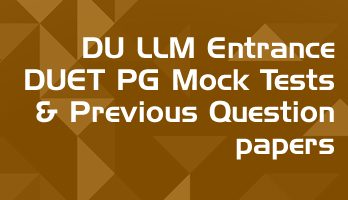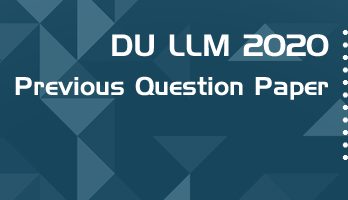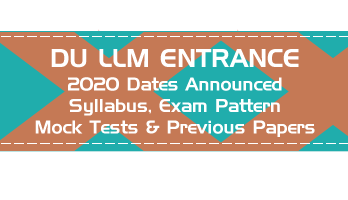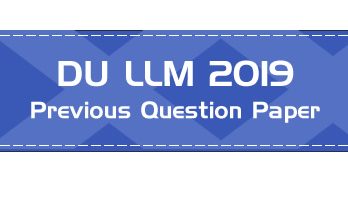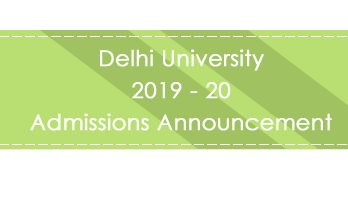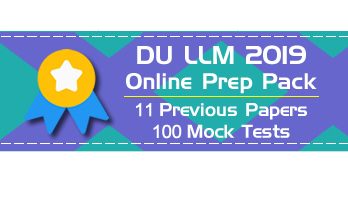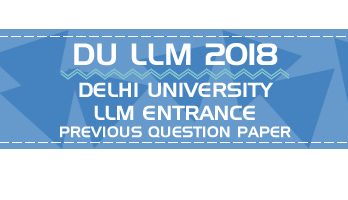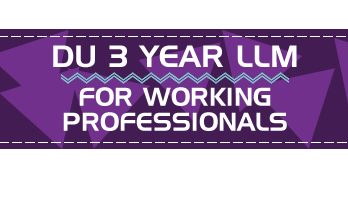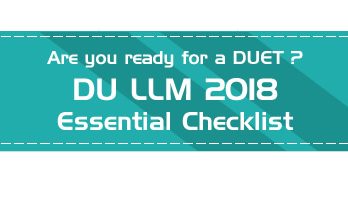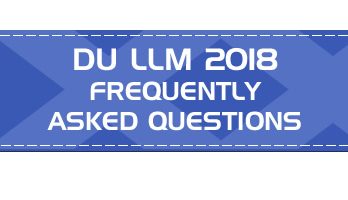This is the Delhi University LLM Entrance Test – DU LLM Entrance 2016 previous question paper for general reference. Answer keys are available for users registered for our DU LLM Prep courses
- Previous years Question Papers, from 2008 to 2021
- 75 Full Length Mock tests of 100 questions each - from a question bank of 9500+ selected MCQs
- 50 Mini Mock tests of 25 questions each - for quick practice sessions
- Each Full Mock Test is designed as a Model Paper
- Summarized overview of Important Jurisprudence topics
- Overview of all Constitutional Amendments
- All Tests & Previous Papers are timed and have Negative marking for realistic simulation
- Questions & Answer Choices randomly shuffled in every attempt for better practice
- Accessible 24 x 7 via Smart-Phone browsers and Desktops
- Over 100 LawMint users were offered LLM seats in 2020 and 2021- including NLSIU, NALSAR, NLU Delhi and IIT KGP LLM
Authentic Feedback from previous LawMint users :
I got AIR 21 in CLAT PG. Thank you so much. Your mocks helped me a lot in my preparation 🙂 - Ayushi Jain
I have subscribed to your CLAT PG program and got AIR 36 in this year CLAT PG. I have also secured AIR 54 in AILET PG exam. I would like to thank you. Your mock paper really helps a lot - Shrashank Tripathi
I would like to thank you for the CLAT PG LLM COURSE. Practising mock tests there helped me in getting confidence and hence I was able to get AIR 45 in CLAT PG LLM - Akshay Awasthi
A year back, I relied on the IIT Kharagpur RGSOIPL mock test series by LawMint to prepare for my RGSOIPL entrance test. Few months back, I relied on your UGC NET Law series to prepare for UGC NET. I was the topper of the RGSOIPL entrance, and have cracked JRF in UGC NET. All thanks to LawMint - Anshuman Sahoo
"I got AIR 18 in CLAT PG and General Category rank 28 in AILET PG. I want to thank you for helping me practice well in controlled conditions from any place. It gave me a lot of confidence and I took the tests while travelling too. I also made it to IIT Kharagpur." - Vinodharani
"Lawmint has been of great help to me in securing AIR 25 in AILET PG and AIR 29 in CLAT PG examinations. The subjective and objective approach of the test series kept me up to date with the latest exam pattern." - Bhawna Nanda
"I, Nimmy Saira Zachariah joined you clat test series. I cleared AILET PG with 30th rank. Your test series were of immense help as it gave me clear idea of where my preparations stand thank you once again law mint." - Nimmy S Z
"Hey guys. Where do I start? If I thought that getting AIR 59 in Clat PG was it, then how wrong I was. With Lawmint now I have cracked UGC NET as well." - Joyanta Chakraborty
Instructions:
There are 175 questions in this DU LLM Entrance Test.
Each question shall carry four marks. For every correct answer, four marks will be awarded and for every incorrect answer, one mark will be deducted.
No mark will be awarded or deducted for a question which is left unanswered.
The complete Question paper + the Official Answer keys are available for users registered for LawMint.com DU LLM Online practice packs. Click on the links above to try the free demo mock tests and buy access to the full practice packs.
[1] Primary responsibility for maintenance of international peace and security is vested with the
A. UN General Assembly
B. International Court of Justice
C. UN Security Council
D. UN Secretary General.
[2] An international act by which a State establishes its consent to be bound by a treaty on the international plane is known as
A. Ratification
B. Full powers
C. State practice
D. Jus cogens.
[3] Article 253 of the Indian Constitution refers to
A. Treaty making
B. Treaty implementation
C. Ratification
D. None of the above.
[4] On partition,………..continued as UN member State.
A. India
B. Pakistan
C. Neither India nor Pakistan
D. Both India and Pakistan.
[5] Which of the following deals with the immunity of State from the jurisdiction of foreign courts?
A. Vienna Convention on the Law of Treaties, 1969
B. Vienna Convention on Diplomatic Relations, 1961
C. UN Convention on Jurisdictional Immunities, 2004
D. UN Charter.
[6] Sources of international law are provided in the
A. UN Charter
B. Statute of the International Court of Justice
C. Vienna Convention on the Law of Treaties, 1969
D. Reports of International Law Commission.
[7] The dispute settlement body established by UN Convention on Law of the Sea, 1982 is known as
A. Permanent Court of Arbitration
B. International Tribunal for Law of the Sea
C. International Court of Justice
D. Permanent Court of International Justice.
[8] Article 51 of the UN Charter refers to
A. Use of force
B. Collective sanction
C. Individual or collective self defence
D. Non-intervention.
[9] A group of people fearing persecution leaves the country of origin is known as
A. Asylum seekers
B. Migrants
C. Refugees
D. Internally displaced persons.
[10] Amendment in the U.N. Charter raising the number of membership in Security Council was made in
A. 1963
B. 1964
C. 1962
D. 1960.
[11] A accesses the email of B unauthorisedly by cracking password and further uses B’s email to send message to B’s uncle pretending that the message is sent by B, requests for depositing thirty thousand rupees in the account number given in the email as his cash has been stolen and he has to urgently deposit the college fees. A commits contravention/offence under which sections of the Information Technology Act, 2000?
A. Sections 43(A), 66C and 66D
B. Sections 43(C), 67 and 66D
C. Sections 66C and 67
D. Sections 43(F) and 66C.
[12] Digital Signature authenticates the electronic record by use of
A. Symmetric cryptosystem
B. Asymmetric cryptosystem
C. Biometrics information
D. All of these.
[13] When a minor becomes a partner on attaining majority, his liability commences from
A. the date of his admission to benefits of the partnership firm
B. the date of majority
C. the date fixed by all the partners
D. the date on which six months will expire from the date of attaining majority by minor.
[14] The liability by holding out, in case of retiring partner, continues up to the
A. Date of retirement
B. Date of public notice about such retirement
C. Date of notice to other partners about such retirement
D. Whichever is earlier out of (A), (B) and (C).
[15] ‘Price’ under the Sale of Goods Act, 1930, means
A. Consideration in money
B. Consideration in money or in kind
C. Any act or abstention for the sale of the goods
D. All of the above.
[16] Unless it is specifically provided in a contract of sale, which of the following will not be regarded as essence of the contract of sale?
A. Stipulation as to the time of performance
B. Stipulation as to the method of the performance
C. Stipulation as to the time of payment
D. Stipulation as to the time of delivery of goods.
[1]. The ‘full faith and credit’ clause in the Constitution deals with
A. Borrowings from the Consolidated Fund of India
B. Borrowings from the Consolidated Fund of the State
C. Jurisdiction of the Union in relation to territories outside India
D. None of the above.
[18] Epistolary jurisdiction of the Supreme Court deals with
A. Letter petitions
B. Extraordinary jurisdiction
C. Ecclesiastical matters
D. Power to punish for contempt of court.
[19] The test of ‘direct and inevitable effect’ is used to determine
A. Overlapping between Lists I and II of the Seventh Schedule
B. Validity of constitutional amendments
C. Infringement of fundamental rights
D. Extraterritorial application of laws.
[20] Article 20(3) states that no person accused of an offence shall be compelled to be a witness against himself. This applies in the case of
A. Narco-analysis
B. Fingerprints
C. DNA sample
D. Handwriting sample.
[21] Religious freedom is guaranteed in the Indian Constitution is subject to
A. Public order
B. Morality
C. Other fundamental rights
D. All of these.
[22] Freedom of speech and expression may be subject to reasonable restrictions imposed by law on the ground of
A. Public health
B. Contempt of court
C. Interests of general public
D. Public policy.
[23] Laws on preservation, protection and improvement of livestock are enacted by the
A. Union
B. States
C. Both Union and States
D. None of the above.
[24] Which one of the following is an incorrect match?
A. Piracy and crimes committed on the high seas => Union List
B. Water supplies => State List
C. Industrial and labour disputes => Union List
D. Adulteration of foodstuffs => State List
[25] Which of the following is not correct?
President shall have the power to grant pardon
A. In death sentence.
B. In cases where the punishment or sentence is for an offence against any law on a matter where the Union executive power extends
C. In cases where the punishment or sentence is by a Court Martial
D. In cases where the punishment or sentence is for an offence against any law on a matter where the State executive power extends
[26] By which Constitutional amendment was the voting age brought down from 21 to 18?
A. 37th Constitutional Amendment of 1985
B. 61st Constitutional Amendment of 1988
C. 56th Constitutional Amendment of 1993
D. 46th Constitutional Amendment of 1985.
[27] What among the following is NOT a power or function of the Speaker of Lok Sabha?
A. When there is a deadlock in vote, the Speaker can cast his casting vote to break the deadlock
B. The Speaker decides whether a bill is a money bill or not
C. The Speaker of the Lok Sabha must resign from the membership of his party after being elected as a Speaker
D. The Speaker of Lok Sabha holds a higher rank than all cabinet ministers except Prime Minister and Deputy Prime Minister.
[28] Which Article states that the Council of Ministers is collectively responsible to the Legislative Assembly of the state?
A. Article 164
B. Article 174
C. Article 184
D. Article 194.
[29] The NJAC Act was declared as unconstitutional in
A. S.P. Gupta v. Union of India
B. In re Presidential Reference of 1998
C. Sakai Chand v. Union of India
D. SC Adv. on Record Association v. Union of India.
[30] In which of the following cases, the notification of 4th March, 2014 regarding Jat reservation was set aside?
A. Ram Singh v. Union of India
B. Ram Kumar v. Union of India
C. Rohtas Industries Ltd. v. S.D. Agarwal
D. Indra Sazvhney v. Union of India
[31] Harish Chandra Singh Raivat v. Union of India deals with
A. promulgation of President Rule in the State of Uttarakhand
B. removal of pornographic material from websites
C. imposition of President rule in Arunachal Pradesh
D. the rights of transgender in India.
[32] “The constitutional protection in Article 21 which protects the right of the person for a fair trial is, in law, a valid restriction operating on the right to free speech under Article 19(1)(A), by virtue of force of it being constitutional provision.” In which of the following cases the aforesaid observation was made by Supreme Court?
A. Sahara India Real Estate v. Securities & Exch. Board of India
B. Shreya Singhal v. Union of India
C. Dr. Subramanian Swamy v. Dr. Manmohan Singh
D. PUCL v. Union of India
[33] In which of the following cases, the Supreme Court struck down section 66A of the Information Technology Act, 2000?
A. Sakai Papers (P) Ltd. v. Union of India
B. S. Khushboo v. Kanniamal
C. Shreya Singhal v. Union of India
D. PUCL v. Union of India.
[34] Which of the following is not correct about the 93rd Constitutional amendment by which Article 15(5) was inserted in the Constitution?
A. State may make special provision for socially and educationally backward classes of citizens or for Scheduled Castes or Scheduled Tribes
B. This provisions relate to their admission in educational institutions
C. This provision applies to all educational institutions, aided or unaided
D. This provision applies to all educational institutions including minority institutions.
[35] State may create a monopoly complete or partial with respect to
A. Article 19(l)(a)
B. Article 19(1 )(c)
C. Article 19(l)(g)
D. Article 19(l)(e).
[36] The Prohibition of Employment as Manual Scavengers and Their Rehabilitation Act, 2013 is to ensure
A. the dignity of the individual, one of the goals in the Preamble
B. right to live with dignity implicit in the fundamental rights
C. protection of the weaker sections from social injustice and all forms of exploitation as provided in Article 46
D. All of the above.
[37] Article 39B. and C. directs the State policy to secure the following
A. Operation of the economic system does not result in the concentration of wealth and means of production to the common detriment
B. Ownership and control of the material resources of the community are so distributed as best to sub-serve the common good
C. Childhood and youth are protected against exploitation and against moral and material abandonment
D. Both A. and (b).
[38] In which of the following cases, the Supreme Court established the relationship between Articles 14, 19 and 21 of the Constitution?
A. R.C. Cooper v. Union of India
B. A K. Gopalan v. State of Madras
C. Maneka Gandhi v. Union of India
D. Minerva Mills v. Union of India
[39] The definition of ‘State’ under Article 12 of the Constitution is
A. limited to Part III unless the context otherwise requires
B. applicable to all parts of the Constitution
C. limited to Part IV
D. limited to Part V.
[40] Article 16(4) refers to
A. Meritorious representation
B. Adequate representation
C. Numerical representation
D. Proportionate representation.
[41] Which of the following is correct about reservation in public employment?
A. Determination of backwardness shall be on the basis of social and educational criteria
B. Backward classes can be divided into backward and more backward categories
C. Backward classes can be identified only and exclusively with economic criterion
D. ‘provision’ in Article 16(4) means law made by the Parliament only.
[42] Advice by the Council of Ministers to the President is
A. Excluded from judicial review
B. Subject to judicial review
C. Subject to judicial review in some circumstances
D. Excluded from judicial review in some circumstances.
[43] Corporation aggregate means
A. A group of persons
B. A community of already existing persons
C. A society of legal persons
D. An incorporated group of coexisting persons.
[44] A right which has a co-relative duty can be legally enforced is called
A. an antecedent right
B. a remedial right
C. a perfect right
D. an imperfect right.
[45] Ownership is “a right indefinite in point of user unrestricted in point if disposition and unlimited in point of duration over a determinate thing”, was stated by
A. Austin
B. Bentham
C. Roscoe Pound
D. Dias.
[46] Which of the following is an incorrect pair according to Roscoe Pound?
A. Public interest => of the State as a guardian of social interest
B. Individual interest => personality
C. Social interest => security of social interest
D. Social engineering => law has its source in the general consciousness
[47] Which of the following is an incorrect pair?
A. Hans Kelsen => Pure Theory of Law
B. W. Friedmann => Law’s Empire
C. Lon L. Fuller => The Morality of Law
D. Julius Stone => The Province and Function of Law
[48] Which of the following is incorrect?
A. According to Allen Buchanan, ‘right’ is not an economic concept.
B. According to Bhiku Parekh, it is possible to define ‘right’ in a non- aggressive, non-exclusive and non absolutist manner.
C. John Stuart Mill’s essay on Liberty excluded the backward nation, women and children from the right to liberty.
D. According to Hohfeld, liability is jural contradictory of disability.
[49] Savigny’s view of the law was first presented in the famous pamphlet “Of the Vocation of our Age for Legislation and Jurisprudence”. This pamphlet was
A. a reaction against natural law theory
B. a reaction against the analytical theory of John Austin
C. a reaction to the proposals made by Professor A.F.J. Thibaut for the codification of the laws and customs of the German States on the basis of Roman Law and Napoleonic code
D. a suggestion for the codification of the laws and customs of the German States on the basis of Roman law as Roman law had become the Germanic Volksgeist
[50] In order that a local custom may be valid and operative as a source of law, which of the following requirements besides antiquity are to be satisfied?
(1) Reasonableness
(2) Conformity with statute
(3) Observance as a matter of moral right
Select the correct answer using the Options given below:
[Options]
A. (1), (2) and (3)
B. (2) and (3)
C. (1) and (3)
D. (1) and (2).
[51] ‘Positive law’ is called positive because it is
A. made as a result of divine providence
B. made as a result of collective effort
C. made by a person in authority
D. followed by everybody.
[52] The Supreme Court in State Trading Corporation of India v. Commercial Tax Officer (1963), observed that a company registered under the Companies Act, 1956
A. is a legal person but it cannot avail itself of fundamental rights under the constitution available to citizen only
B. can neither claim legal personality nor right of a citizen
C. is like a citizen of India and can avail itself of all rights available to citizens of India.
D. is a legal person and equivalent to a group of citizens
[53] Hans Kelsen talked about
A. Validity and rigidity of norms
B. Validity and propriety of norms
C. Validity and effectiveness of norms
D. Validity and solidity of norms.
[54] Customs not only precede legislations, but are even superior to it. Match it with one of the following
A. Sir Henry Maine
B. Puchta
C. Hugo Von Savigny
D. Roscoe Pound.
[55] Just as Immunity is freedom from the power of another, liberty is
A. freedom from the claim of another
B. freedom from disability
C. freedom from suffering and misery
D. freedom in every sense.
[56] “I have a right to do as I please.” The term ‘right’ in this statement refers to
A. Claim
B. Power
C. Liberty
D. Immunity.
[57] Which statement below is the least likely to follow logically from Savigny’s notion of a Volksgeist?
A. A society’s law is a reflection of its culture
B. Law is like language
C. Law is influenced hugely by religion
D. Law is an integral element of the social fabric.
[5]. Maine’s famous aphorism that ‘the movement of progressive societies has hitherto been a movement from Status to Contract’ is often misunderstood. In what way?
A. His idea is considered inapplicable to Western legal systems
B. It is misinterpreted as a prediction
C. Because Status can never lead to Contract
D. Because Status and Contract are two unrelated concepts.
[59] If a norm is for long disregarded in practice and the courts no longer follow it in deciding cases; such a disuse of norms is called as
A. Desuetude
B. Staticness
C. Nomodynamics
D. Repulsion.
[60] The corpus of law was classified by Austin. Which is the odd one out?
A. Positive law
B. Divine law
C. Positive morality
D. Laws by metaphysics.
[61] Which one of the following is the correlative of immunity?
A. Liability
B. Duty
C. No claim
D. Disability.
[62] In Jurisprudence, ‘Bracket theory’ is related with
A. Fundamental Duty
B. Ratio decidendi
C. Legal personality
D. Possession.
[63] The physical element of possession is also called as
A. Ratio decidendi
B. Corpus decidendi
C. Corpus possessionis
D. Animus possidendi.
[64] Right-Duty correlation is propounded by:
A. Austin
B. Fuller
C. Hohfeld
D. Cardozo.
[65] The following is not the essential of ownership
A. Temporal in duration
B. Animus possidendi
C. Exclusion of others
D. Absoluteness of right.
[66] Hierarchy of “oughts” is traceable to
A. Pure theory of Law
B. Realistic theory of Law
C. Combination of Primary and Secondary Rules
D. None of the above.
[67] X, a surgeon, amputates the right hand index finger of ‘Y, a 14-year old beggar, with Y’s consent, and in good faith that this would enable ‘Y to get more alms. In this case
A. ‘X’ commits no offence as the act was done with the Y’s consent.
B. ‘X’ commits an offence as the consent of a child of 14 years is of no avail.
C. ‘X’ commits no offence as the act was done in good faith for the benefit and with the Y’s consent.
D. ‘X’ is not exempted from criminal liability as the act done was not in good faith within the meaning of IPC.
[68] Hazarding a dangerous or wanton act with the knowledge that it is so, and that it may cause injury, but without intention to cause injury, or knowledge that it will probably be caused implies
A. criminal rashness
B. criminal negligence
C. both A. & (b)
D. none of these.
[69] Which of the following is not essential for the offence of kidnapping?
A. Minor child
B. Intention of the accused
C. Without the permission of lawful guardian
D. None of the above.
[70] A bullock cart carrying a box of treasure is intercepted by ‘A’. The offence of theft is committed by ‘A’ if and as soon as
A. he seizes the bullock
B. the bullock is made to move by him in his direction
C. he takes the box of treasure
D. he takes the valuable contents of the treasure.
[71] Z takes away a golden chain of his wife which was given by her father a Stridhan, without her consent, and pledges it to raise money for domestic use Z is
A. not guilty of theft as the chain was their joint property
B. not guilty of theft as the property was temporarily taken away
C. guilty of theft
D. guilty of criminal misappropriation.
[72] Which of the following is an offence which is punishable in four stages?
A. Robbery
B. Dacoity
C. Murder
D. Rape.
[73] On the non-completion of investigation i.e., failure of the prosecution to file charge sheet within the prescribed period of 90 or 60 days
A. The accused person is to be discharged
B. The accused person shall be released on bail if he is prepared to and does furnish bail
C. The accused person shall be released on bail as of right and no application for release on bail need be made
D. The right of the accused person to be released on bail could be defeated by the subsequent filing of the charge sheet under any circumstance.
[74] An Executive Magistrate is empowered to grant remand under section 167 of the Code of Criminal Procedure, 1973 for a maximum period of
A. 15 days
B. 7 days
C. 60 days
D. 90 days.
[75] Under which section of IPC, the offence of trafficking of person is defined?
A. Section 362
B. Section 370
C. Section 370A
D. Section 363A.
[76] Which of the following sections of IPC deals with Gang Rape?
A. Section 376A
B. Section 376D
C. Section 376C
D. Section 376E.
[77] Law Commission of India 2015 report deals with
A. juvenile justice
B. sexual offences
C. death penalty
D. all of these.
[78] A while leaving the examination hall as the last student, finds a watch on the floor and keeps it to himself. What offence, if any, has been committed by A1
A. Criminal breach of trust
B. Theft
C. Extortion
D. Criminal misappropriation of property.
[79] The right against self-incrimination under Article 20(3) and section 161(2) of Cr. P.C. was recognised by the Supreme Court in the case of
A. Gian Kaur v. State
B. Rupan Deal Bajaj v. K.P.S. Gill
C. Nandirti Satpathy v. P.L. Dani
D. Joginder Kumar v. State.
[80] The difference between section 34 and section 149 of IPC is that
A. Section 34 deals with group liability whereas section 149 deals with unlawful assembly
B. Section 34 requires five persons whereas section 149 requires minimum of two
C. Section 34 requires active participation whereas section 149 is attracted even on membership of the unlawful assembly
D. Section 34 is a substantive offence whereas section 149 is a rule of evidence only.
[81] Which of the following statements about Indian Penal Code is true?
A. The Indian Penal Code applies to every person in any part of India for every act or omission contrary to the provisions of the Code
B. The Indian Penal Code applies to any offence committed by any citizen of India within and beyond India
C. Every such act committed outside India which if committed in India, would be punishable under the Indian Penal Code
D. All of the above.
[82] In which of the following cases the Supreme Court applied the ‘locus penitentiae’ rule?
A. Om Prakash v. State of Punjab
B. Malkiat Singh v. State of Punjab
C. State of Maharashtra v. Mohd. Yakub
D. Abhayanand Mishra v. State of Bihar.
[83] Intoxication is an excusable defense to criminal liability if it is
A. administered against the will of the offender
B. administered without the knowledge of the offender
C. both A. and B. above
D. none of the above.
[84] ‘Malice in fact’ means a wrongful act done intentionally
A. without any just cause or excuse
B. with evil motive
C. without evil motive
D. none of the above.
[85] Match List I with List II and select the correct answer using the Options given below:
[List ]
Principle
A. Negligence
B. Scienti non fit injuria
C. Defamation
D. “Eggshell Skull” Rule
[List II]
Associated case
(1) Tolley v. J.S. Fry & Sons
(2) Grant v. Australian Knitting Mills
(3) Smith v. Leech Brain & Co. Ltd.
(4) Smith v. Baker
[Options]
A. (a)—(3), (b)-(1), (c)—(2), (d)—(4)
B. (a)—(1), (b)—(3), (c)—(4), (d)—(2)
C. (a)—(2), (b)—(4), (c)-(1), (d)—(3)
D. (a)—(4), (b)—(2), (c)—(3), (d)-(1).
[86] For the tort of defamation, the presence of malice destroys
A. the defence of qualified privilege
B. the defence of absolute privilege
C. the defence of both absolute and qualified privileges
D. the defence of neither absolute privilege nor qualified privilege.
[87] Which one of the following statements is incorrect?
A. An innocent principal is not liable for the fraud of his agent fo) The general rule that employer is not liable for tort committed by the independent contractor is not applicable in cases of strict liability
B. An act is deemed to be done in the course of employment, if it is a wrongful act authorized by the master
C. An act is deemed to be done in the course of employment, if it is a wrongful and unauthorized mode of doing an act authorized by the master
[88] The maxim ‘res ipsa loquitur’
A. shifts the burden of proving negligence on the plaintiff
B. shifts the burden of disproving negligence on the defendant
C. is a rule of evidence
D. both B. and (c).
[89] The rule laid down in Re Polemis case is that the defendant shall be liable for all:
A. direct consequences of his act
B. direct consequences of his act only if he could foresee the kind of damage which has actually occurred
C. direct consequences of his act if he could foresee some damage to the plaintiff from his act
D. only for foreseeable damage.
[90] Who is the Chairman of the Central Consumer Protection Council?
A. A person appointed by the President of India
B. Minister In charge of Consumer Affairs in the Central Government
C. Chief Justice of India
D. President of the National Consumer Dispute Redressal Commission.
[91] What is the tenure of the members in District Consumer Redressal Forum?
A. The term of five years or up to the age of 65 years whichever is earlier
B. The term of five years or up to the age of 70 years whichever is earlier
C. The term of two years or upto the age of 65 years whichever is earlier
D. A term of 5 years or upto the age of 62 years whichever is earlier.
[92] According to the ‘objective theory of negligence’, negligence is a
A. state of mind
B. type of conduct
C. state of heart
D. all of these.
[93] The terms Culpa lata and Culpa levis mean
A. Gross negligence and negligence of a smaller degree
B. Culpable and non-culpable
C. Cognizable and non-cognizable
D. Civil liability and criminal liability.
[94] For the defence of volenti non-fit injuria, it is necessary that
A. The plaintiff knowing that risk is there, agrees to suffer the harm
B. The plaintiff agrees to suffer the harm
C. The plaintiff knows that risk is there
D. The plaintiff agrees to suffer the harm without knowing that risk is there.
[95] In which of the following cases it is not nuisance
A. Playing music through loudspeaker at night
B. Washing clothes at a public tap
C. Construction of a flour mill on the ground floor, while the upper floors are used for residential purpose
D. Creation of foul smell on one’s land which reaches neighbors.
[96] Vis major is an
A. Action of an enemy
B. Accident with strict liability
C. Accident which can be controlled by human action
D. Inevitable accident due to natural forces beyond human control.
[97] A master’s liability for the act of his servant is based
A. On the doctrine of necessity
B. On morality
C. On the maxim of respondent superior
D. In the interest of trade and commerce.
[98] W, a woman got pregnant inspite of sterilization operation. Will the doctor who performed sterilization operation be held liable on grounds of negligence?
The doctor would
A. Be liable only if there is proof that he was negligent in performing sterilization
B. Be liable as pregnancy could not have occurred in the absence of negligence on the part of doctor
C. Not be liable as the doctor performed the operation to the best of his ability
D. Be liable as occurrence of pregnancy after sterilization is a sure proof of negligence
[99] What is the basis of a ‘Duty’ for Tort of Negligence?
A. Principle of equity
B. Foreseeability of a reasonable man
C. Morality of the enterprise
D. Contractual relationship between parties.
[100] By which Amendment to the Consumer Protection Act, 1986 the services availed of by a person for any commercial purpose was excluded from the definition of Consumer?
A. By 1993 Amendment
B. By 2002 Amendment
C. By 2010 Amendment
D. It is not excluded.
[101] The careless operations of railways that led to fire in the bogie standing in the platform attracted a few public spirited rescuers standing on the platform to rush in to extinguish the fire. In the course of rescue operation a rescuer was gravely injured. Can he bring tort action against the railways?
A. No, the railways had a team of expert rescuers who would have acted in any case
B. Yes, because the dangerous situation by railways’ carelessness had invited the rescuers
C. No, because his injuries were voluntarily assumed by him
D. None of the above.
[102] “A” had constructed a temporary structure on a land belonging to the Municipal Corporation in which he ran a flourishing restaurant that was frequented by elites of the town. The Municipal Corporation constructed a huge Public Toilet in the plot adjoining A’s famous restaurant. Does A have any remedy under Tort Law?
A. He has remedy to get the Municipal Corporations’ action stopped as it constituted a nuisance
B. He had the freedom to hedge the restaurant by putting up screens and boards
C. He has no remedy because he did not own the plot
D. None of the above.
[103] “Nothing connected with the internal disputes between the shareholders is to be the subject of an action by a shareholder.” This majority rule was laid down in the celebrated case of
A. Bharat Insurance Co. Ltd. v. Kanhaiya Lai, AIR 1935 Lah 792
B. Brown v. British Abrasive Wheel Co. (1919) 1 Ch 290
C. Foss v. Harbottle, (1843) 2 Hare 461: 67 ER 189.
D. Lagunas Nitrate Co. v. Lagunas Syndicate, (1899) 2 Ch 392.
[10]. The statutory formulation of directors’ duties under Companies Act, 2013 have been spelt out in
A. Section 166
B. Section 151
C. Section 171
D. Section 289.
[
105.]The first Annual General Meeting of a Company must be held
A. within nine months from the date of closing of the first financial year
B. within five months from the date of closing of the first financial year
C. within four months from the date of closing of the first financial year
D. within three months from the date of closing of the first financial year.
[106] The provision of Companies Act, 2013 relating to application to Tribunal for prevention of oppression and mismanagement is contained in
A. Section 241
B. Section 349
C. Section 361
D. Section 344.
[107] A company shall be deemed to be unable to pay its debts:
A. if the company has failed to pay the sum within 21 days after the receipt of such demand
B. if any execution process issued on a decree in favour of a creditor is returned unsatisfied
C. if it is proved to the satisfaction of the Tribunal that the company is unable to pay its debts
D. all of the above.
[108] The preamble of Indian Contract Act, 1872 states
A. Whereas it is expedient to define and amend certain parts of the law relating to contracts;
B. Whereas it is expedient to define certain parts of the law relating to contract;
C. Whereas it is expedient to define and amend the law relating to contract;
D. Whereas it is expedient to amend certain parts of the law relating to contract;
[109] B accepts the proposal of A by posting a letter of acceptance to A. The above acceptance
A. cannot be revoked by B as he has already accepted the offer and dropped the letter of acceptance.
B. can be revoked by B before the letter of acceptance reaches A
C. can be revoked by B at any time before B performs the contract’
D. can be revoked by B at any time before A actually performs the contract
[110] Section 2(D) of Indian Contract Act says: “When, at the desire of the promisor, the promisee or any other person has done or abstained from doing, or does or abstains from doing, or promises to do or abstain from doing, something, such act or abstinence or……………… is called a consideration for the promise.”
A. approval
B. obligation
C. promise
D. undertaking.
[111] Past consideration means
A. money received in the past without making even a proposal
B. the price which is more than the promisor’s past expectations
C. the price paid or service rendered at the desire of the promisor followed by a subsequent promise
D. consideration that was valuable in the past but has ceased to be of any value at the time of performance of contract
[112] A promise to pay wholly or in part a debt of which the creditor might have enforced payment, but for the law of limitation of suits is a contract
A. if it is made in writing only
B. if it is made in writing and registered under the law for the time being in force
C. if it is made in writing and signed by the person to be charged therewith
D. even if made orally.
[113] According to section 16(1), Indian Contract Act: “A contract is said to be induced by “undue influence” where the …………. between the parties are such that one of the parties is in a position to dominate the will of the other and uses that position to obtain an unfair advantage over the other.”
A. relations subsisting
B. relations
C. fiduciary relations
D. associations.
[114] A person is deemed to be in a position to dominate the will of another
A. where he holds an apparent authority over the other
B. where he holds a real authority over the other
C. where he makes a contract with a person whose mental capacity is temporarily or permanently affected by reason of age, illness or mental or bodily distress
D. all of the above.
[115] ‘C’ let a music hall to ‘X’ for a series of music concerts for certain days. The hall was completely destroyed by fire before the scheduled date of concerts. In this case
A. ‘C’ cannot be discharged from performance of the contract
B. the contract becomes voidable at the option of ‘X’
C. the contract is discharged by impossibility of performance
D. the contract is void ab initio.
[116] When any person enters into any bail – bond, recognizance, etc. or under the provision of any law or under the Government’s order, gives any bond for the performance of any public duty/act, he shall be liable upon breach to pay
A. the sum as considered reasonable by the court
B. the whole sum mentioned therein
C. Either A. or (b)
D. None of the above.
[117] Which one of the following is a contingent contract?
A. ‘A’ insures his factory against damage or destruction by fire
B. ‘A’ sells his property subject to the condition that the property will be reconvened to him on repayment of price with interest
C. A guard is appointed at a swimming pool for the sole purpose of rescuing drowning persons
D. A borrower solemnly promises to pay off the lender when the borrower will be in funds.
[118] The remedy/remedies for breach of contract provided under the Indian Contract Act is/are
A. Injunction
B. Damages
C. Specific performance
D. All of these.
[119] Exceptions to the doctrine of ‘privity of contract’ do not include
A. beneficiaries under a charge
B. equitable mortgage
C. estoppel
D. marriage settlement.
[120] ‘V places an order with ‘S’ for the supply of 20 sewing machines. ‘S’ could not supply these in time. ‘V loses a profitable contract due to this (a fact that was not communicated to ‘S’) and claims his loss of profit from ‘S’. But ‘V’ does not succeed as the nature of the damage is:
A. foreseeable
B. remote
C. ordinary
D. special.
[121] The loss or damage arising from a breach of contract has to be ascertained
A. at the date of the breach of contract
B. at the time of making of contract
C. at the discretion of Court
D. none of the above.
[122] A person, who sues for damages, under the law of contract
A. has a duty to mitigate the loss consequent upon the breach of contract
B. has no duty to mitigate the loss consequent upon the breach of contract
C. can claim damages for the sum inclusive of the amount of loss due to his negligence
D. has entire discretion in the matter.
[123] Money paid under mistake or coercion is recoverable if there is
A. mistake of law
B. mistake of fact
C. both (A) and (B) are correct
D. none of the above.
[124] Hadley v. Baxendale is a leading case on
A. Anticipatory breach
B. Remoteness of damages
C. Breach of implied terms
D. All of these.
[125] Consensus ad idem means
A. Common intention
B. Meeting of minds
C. Theme of contract
D. None of these.
[126] The display of articles in a showroom with prices amounts to
A. Offer to sell articles at prices mentioned
B. Counter offer
C. Invitation to offer
D. Mere advertisement.
[127] The contract of uberrrima fides means
A. A contract of goodwill
B. A contract guaranteed by surety
C. A contract of utmost good faith
D. None of the above.
[128] Which of the following is not a quasi-contract?
A. Obligation of a person enjoying benefit of non-gratuitous Act
B. Responsibility of finder of goods
C. Liability of person to whom money is paid, or a thing delivered, by mistake or under coercion
D. Novation.
[129] A, a Hindu husband files a petition of divorce on the ground of his wife B’s adultery. Since B does not have sufficient income to defend herself she asks for maintenance pendente lite. The main consideration to decide her claim is
A. the income of the husband alone
B. the income of the wife alone
C. the conduct and character of the wife
D. none of the above.
[130] A and his son B, constituted a Mitakshara coparcenary. A gives his only son B in adoption to C. After adoption
A. B carries his coparcenary interest with him
B. B cannot carry his coparcenary interest
C. AB may carry his coparcenary interest according to his wishes
D. None of the above.
[131] A Mitakshara Joint family consists of father F, two minor sons SI, S2 and a major daughter D. After the death of the father in 2002
A. D can be the karta of the family
B. D can’t be the karta of the family
C. D can be karta depending upon the consent of other coparceners
D. None of the above.
[132] A, a male Hindu marries B, a female Hindu according to Hindu rites & ceremonies. A obtains a decree of judicial separation against B. Afterwards, B wants to adopt a Hindu son. Which of the following is correct?
A. B has no right of adoption
B. B can adopt a son of her own
C. B can adopt only after obtaining A’s consent
D. None of the above.
[133] Under classic Hindu law, a ‘widow’s estate’ was the estate in which a Hindu female had
A. Limited ownership
B. Absolute ownership
C. No rights
D. Interest for life.
[134] The Hindu Marriage Act, 1955 has
A. only territorial applicability
B. only extra-territorial applicability
C. territorial and extra-territorial applicability
D. applicability in India and other commonwealth countries.
[135] A, a Hindu male marries B, a Hindu female. At the time of marriage B was suffering from unsoundness of mind. On the ground of alleged disability
A. A can ask for divorce
B. B can ask for divorce
C. Either of them can ask for a decree of judicial separation
D. B can ask for a decree of nullity.
[136] Which of the following States was first to make daughter, a coparcener?
A. Karnataka
B. Andhra Pradesh
C. Maharashtra
D. Kerala.
[137] Conversion to another religion by a married Hindu under the Hindu Marriage Act, 1955
A. automatically dissolves the marriage.
B. does not automatically dissolve the marriage.
C. may or may not automatically dissolve the marriage depending on the facts and circumstances of the case.
D. discretionary to the court to take the marriage automatically dissolved or not.
[138] In the Schedule of Hindu Succession Act, 1956 as amended in September 2005, the number of heirs have been increased in
A. heirs of class I of the Schedule
B. heirs in class II of the Schedule
C. heirs in both classes I and II of the Schedule
D. no changes have been made
[139] Disqualification under section 25 of the Hindu Succession Act, 1956 is
A. confined only to the person who committed murder
B. confined only to those claiming title through person who committed murder
C. confined not only to the person who committed murder but also extends to the persons claiming through him
D. confined only to the person who abetted murder.
[140] A, a Male Christian adopts a Hindu child. The adoption is
A. Void
B. Voidable
C. Valid
D. Irregular.
[141] A, a Sunni male Muslim marries B, a Sunni female Muslim, who happens to be his first wife’s sister. The marriage is
A. Valid
B. Void
C. Irregular
D. Invalid.
[142] Who has no right to partition under Hindu law?
A. Mother
B. Son, grandson and great grandson
C. Son conceived at the time of partition
D. None of the above.
[143] A right to divorce under section 13(2)(1) of Hindu Marriage Act, 1955 has been given to
A. The first wife
B. The second or subsequent wife or wives
C. The first wife as well as the second or subsequent wife or wives
D. None of the above.
[144] Bigamy under Hindu Law is committed by a person who marries during the lifetime of his or her spouse provided
A. The first marriage is valid
B. The first marriage is null and void
C. The first marriage is voidable and no court’s decree annulling first marriage has been obtained
D. Both A. and (c).
[145] Fine prescribed under section 18 of Hindu Marriage Act, 1955 for child marriage may extend to
A. Rs. 5,000
B. Rs. 3,000
C. Rs. 1,00,000
D. None of these.
[146] Can a Hindu marry second time on the basis of written consent of his first wife?
A. Yes
B. No
C. Yes, if wife is more than 21 years of age
D. Yes, if wife does not give birth to any child in last 10 years.
[147] Marriages which are irregular under the Sunni Law, under the Shia Law, the same are
A. Valid marriages
B. Void marriages
C. Voidable marriages
D. Either valid or void as decided by the Qazi.
[148] The period of “Iddat” in Muslim Law is
A. The period when Muslim women observe fasting after the death of their husbands
B. The period during which the Muslim women are free to leave their husbands and marry another man
C. The period of limitation during which the Muslim women can claim back the dower from their divorced husbands
D. The period of seclusion to be observed by a Muslim woman whose marriage has been dissolved by divorce or death.
[149] Any Member of Parliament (MP), Member of the Legislative Assembly (MLA) or Member of a Legislative Council (MLC) who is convicted of a crime with more than two year sentence, will be disqualified as an elected representative on the date of conviction. In which of the following verdict, the Supreme Court opined so which sent waves of panic amongst the government
A. Prakash v. Phulavati (2015)
B. Lily Thomas v. Union of India (2013)
C. ABC v. The State (NCT of Delhi) (2015)
D. PUCL v. Union of India (2013).
[150] The Constitutionality of the Haryana Panchayti Raj (Amendment) Act, 2015 was challenged in
A. Raj Bala v. State of Haryana
B. Raj Singh v. State of Haryana
C. Chaudhary Charan Singh v. State of Haryana
D. Kiran Bala v. State of Haryana.
[151] In Reserve Bank of India v. Jayantilal N. Mistry, the court observed that:
A. RBI comes within ambit of Right to Information Act, 2005
B. RBI does not come within ambit of Right to Information Act, 2005
C. RBI being highest independent banking authority does not come within ambit of Right to Information Act, 2005
D. None of the above.
[152] Under the Biodiversity Act, 2002, which of the following users of biodiversity is not exempted from the requirement of prior intimation to the State Biodiversity Board for the purpose of obtaining of bio resources for commercial exploitation?
A. Cultivators of biodiversity
B. Local people of the area
C. An organisation registered in India
D. Hakims practising indigenous medicine.
[153] In which of the following cases, it was held that “there is no reason to compel non-smokers to be helpless victims of air pollution”?
A. Murli S. Deora v. Union of India
B. Samatha v. State of A.P.
C. M.C. Mehta v. Union of India
D. PUCL v. Union of India.
[154] The ‘Doctrine of Public Trust’ was propounded by the Supreme Court in the case of
A. Indian Council for Enviro-Legal Action v. Union of India, AIR 1996 SC 1446
B. M.C. Mehta v. Katnal Nath, (2000) 6 SCC 213
C. M.C. Mehta v. Union of India, (1997) 2 SCC 353
D. M.C. Mehta v. Union of India, (1988) SCC 1115
[155] The National Green Tribunal Act, 2010 was enacted as a response to
A. The 180th Report Commission of India of the Law
B. The 184th Report Commission of India of the Law
C. The 186th Report Commission of India of the Law
D. The 190th Report Commission of India. Of the Law
[156] Which of the following statements is incorrect?
A. Moral rights are available only to the author of work
B. Moral rights can be exercised after the assignment of copyright
C. The moral rights available in India are the right of authorship of the work and the right of integrity with respect to that work
D. All moral rights cannot be claimed by legal representatives of the author after his death.
[157] Who is author in relation to a cinematograph film?
A. Producer
B. Director
C. Composer
D. Artist.
[158] Which of the following statements is correct?
A. Copyright is protected only under common law.
B. Copyright is protected only under Copyright Act, 1957.
C. Copyright is protected both under Copyright Act, 1957 and common law.
D. Copyright is protected at the option of author of a work. The author, however, cannot claim copyright in his work both under Copyright Act, 1957 and common law at the same time. He has to opt one of the two.
[159] In Kapil Wadhiva v. Samsung Electronics Co. Ltd. (2012), the Delhi High Court held that under Trade Marks Act, 1999
A. the principle of domestic exhaustion of rights is applicable in India.
B. the principle of regional exhaustion of rights is applicable in India.
C. the principle of international exhaustion of rights is applicable in India.
D. the principle of exhaustion of rights is not applicable in India.
[160] A new variety shall be registered under the Protection of Plant Varieties and Farmers’ Rights Act, 2001 if it conforms to the criteria of
A. Novelty, distinctiveness and stability
B. Novelty, inventiveness, uniformity and stability
C. Novelty, distinctiveness, uniformity, inventiveness and stability
D. Novelty, distinctiveness, uniformity and stability.
[161] Which of the following is patentable under the Patents Act, 1970?
A. Micro-organisms
B. Plants
C. Animals
D. Seeds.
[162] Who appoints Secretary-General of the United Nations?
A. Secretariat on the joint recommendations of General Assembly and Security Council
B. General Assembly on the recommendations of the Security Council
C. Security Council on the recommendations of the General Assembly
D. Secretariat on the recommendations of the General Assembly.
[163] The right to exploit living organisms belonging to sedentary species can be exercised in
A. Territorial waters and contiguous zone
B. Contiguous zone only
C. Exclusive economic zone only
D. Continental shelf only.
[164] Which of the following elements is essential for a practice to become a custom?
A. Jus cogens
B. Pacta sunt servanda
C. Opinion juris sive necessitates
D. Rebus sic stantibus.
[165] In the Report of the Office of the High Commissioner for Human Rights (OHCHR) Investigation on Sri Lanka (OISL) of 16 September, 2015, it has been recommended to try war crimes and crimes against humanity, including sexual crimes and crimes committed against children by
A. International Criminal Court
B. An ad hoc hybrid special court
C. International Court of Justice
D. Apex Court of Sri Lanka.
[166] Find out the incorrect match from the following
A. Temple of Preah Vihear case – Cambodia v. Thailand
B. Island of Palmas case – Netherlands v. Spain
C. Corfu Channel case – Great Britain v. Albania
D. Asylum case – Columbia v. Peru
[167] Which of the following is a specialized Agency of the United Nations?
A. Trusteeship Council
B. World Intellectual Property Organization
C. U.N. Human Rights Committee
D. OPEC.
[168] Which of the following statements is incorrect about Hugo Grotius?
A. He is called the “Father of Law of Nations”.
B. He wrote Mare Liberum.
C. He was a positivist.
D. Grotius considered law of nature as an independent source of international law, apart from customs and treaties.
[169] An individual can file a petition before Human Rights Committee only if his/her country is a party to the
A. United Nations Charter
B. Universal Declaration of Human Rights
C. International Covenant on Civil and Political Rights
D. First Optional Protocol to International Covenant on Civil and Political Rights.
[170] imposed a duty of non recognition of all territorial acquisitions brought about in breach of international law?
A. Incorporation doctrine
B. Estrada doctrine
C. Stimson doctrine
D. Blackstonian doctrine.
[171] Which of the following statements is incorrect?
A. The recognition may be express or implied
B. The recognition may be de jure or de facto
C. Ordinarily, the recognition operates prospectively and not retrospectively
D. Collective recognition may be conferred through the medium of an international institution.
[172] Which of the following is mentioned as a source of international law under Article 38(1) of the Statute of International Court of Justice?
A. Equity
B. The teachings of the most highly qualified publicists of the various nations
C. Resolution of General Assembly and Security Council
D. Decisions or determination of the organs of international institutions.
[173] What is the status of the decisions of International Court of Justice?
A. The decisions of ICJ have binding force and operate as precedent.
B. The decisions of ICJ have no binding force except between the parties and in respect of that particular case.
C. The law laid down by ICJ shall prevail even if it is in contravention with a treaty or a custom. Such treaty or custom shall be nullify to the extent of conflict.
D. The decisions of ICJ have only persuasive force.
[174] Which of the following statements is not correct?
A. International Court of Justice consists of fifteen members.
B. Judges of International Court of Justice represent principal legal systems of the world.
C. UN Secretary General appoints judges of the International Court of Justice.
D. Judges of the International Court of Justice enjoy diplomatic immunities and privileges.
[175] A State is admitted into the membership of UN on the recommendation of the
A. UN Secretary General
B. Security Council
C. General Assembly
D. Economic and Social Council.
- Previous years Question Papers, from 2008 to 2021
- 75 Full Length Mock tests of 100 questions each - from a question bank of 9500+ selected MCQs
- 50 Mini Mock tests of 25 questions each - for quick practice sessions
- Each Full Mock Test is designed as a Model Paper
- Summarized overview of Important Jurisprudence topics
- Overview of all Constitutional Amendments
- All Tests & Previous Papers are timed and have Negative marking for realistic simulation
- Questions & Answer Choices randomly shuffled in every attempt for better practice
- Accessible 24 x 7 via Smart-Phone browsers and Desktops
- Over 100 LawMint users were offered LLM seats in 2020 and 2021- including NLSIU, NALSAR, NLU Delhi and IIT KGP LLM
Authentic Feedback from previous LawMint users :
I got AIR 21 in CLAT PG. Thank you so much. Your mocks helped me a lot in my preparation 🙂 - Ayushi Jain
I have subscribed to your CLAT PG program and got AIR 36 in this year CLAT PG. I have also secured AIR 54 in AILET PG exam. I would like to thank you. Your mock paper really helps a lot - Shrashank Tripathi
I would like to thank you for the CLAT PG LLM COURSE. Practising mock tests there helped me in getting confidence and hence I was able to get AIR 45 in CLAT PG LLM - Akshay Awasthi
A year back, I relied on the IIT Kharagpur RGSOIPL mock test series by LawMint to prepare for my RGSOIPL entrance test. Few months back, I relied on your UGC NET Law series to prepare for UGC NET. I was the topper of the RGSOIPL entrance, and have cracked JRF in UGC NET. All thanks to LawMint - Anshuman Sahoo
"I got AIR 18 in CLAT PG and General Category rank 28 in AILET PG. I want to thank you for helping me practice well in controlled conditions from any place. It gave me a lot of confidence and I took the tests while travelling too. I also made it to IIT Kharagpur." - Vinodharani
"Lawmint has been of great help to me in securing AIR 25 in AILET PG and AIR 29 in CLAT PG examinations. The subjective and objective approach of the test series kept me up to date with the latest exam pattern." - Bhawna Nanda
"I, Nimmy Saira Zachariah joined you clat test series. I cleared AILET PG with 30th rank. Your test series were of immense help as it gave me clear idea of where my preparations stand thank you once again law mint." - Nimmy S Z
"Hey guys. Where do I start? If I thought that getting AIR 59 in Clat PG was it, then how wrong I was. With Lawmint now I have cracked UGC NET as well." - Joyanta Chakraborty


